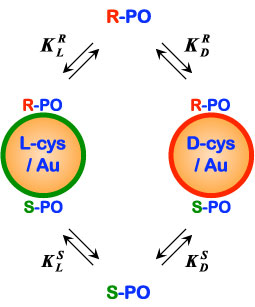| Posted: Jun 10, 2010 | |
Fabrication of gold nanoparticles with chiral surfaces |
|
| (Nanowerk Spotlight) Nanoparticle chirality has attracted much attention among nanoscientists, and the application of chiral nanoparticles in chemistry, biology and medicine is of great importance for the development of new molecular nanosystems. In chemistry, chirality usually refers to molecules. A chiral molecule is a type of molecule that lacks an internal plane of symmetry and has a non-superimposable mirror image. Two mirror images of a chiral molecule are called enantiomers or optical isomers. Pairs of enantiomers are often designated as 'right-handed' and 'left-handed'. | |
| Discovering efficient methods to produce, control and identify enantiomerically pure chiral compounds is critical for the further development of pharmaceuticals, agrochemicals, fragrances and food additives. Chiral substances are already important in daily life: Well known examples of chiral molecules are for instance ibuprofen (one of the most important anti-inflammatory and analgesic drugs) and aspartame (an artificial sweetener). | |
| An important example in the area of nanomaterials is the synthesis of metallic nanoparticles with controlled size, shape, composition, and morphology for catalytic applications. | |
| "Among all forms of catalytic selectivity, enantioselectivity is perhaps the most subtle and the most difficult to control," Nisha Shukla tells Nanowerk. "To this end, the controlled synthesis of enantiomerically pure chiral metal nanoparticles could serve as a new route to enantioselective catalytic materials." | |
| Enantioselective adsorption is an elementary step in many of the methods and technologies used for preparation and purification of enantiomerically pure pharmaceuticals – a multi-billion industry. | |
| Shukla, a researcher at the Institute for Complex Engineered Systems (ICES) at Carnegie Mellon University, notes that over the past decade, there has been considerable interest and effort devoted to the synthesis and characterization of chiral, optically active metal nanoparticles capped with chiral organic ligands. | |
 |
|
The figure illustrates the reversible equilibrium adsorption of R- and S-PO on Au nanoparticles modified with L- or D-cysteine. The equilibrium constants are enantiospecific,  (Image: Dr. Shukla, Carnegie Mellon University) (Image: Dr. Shukla, Carnegie Mellon University)
|
|
| In her most recent work, Shukla and her colleagues use wet chemical synthesis methods to prepare chiral gold nanoparticles and then use polarimetry to show that these chiral nanoparticles are capable of enantioselective adsorption of chiral compounds. | |
| "The fact that these chiral nanoparticles interact enantiospecifically with chiral adsorbates is a key step toward achieving enantiospecific catalysis, separations, and sensing" says Shukla. "Although there are a number of reports of the preparation of chiral gold nanoparticles, we believe that this is the first to demonstrate enantiospecific adsorption on their surfaces." | |
| The Carnegie Mellon team has reported their findings in the June 3, 2010 online issue of Journal of the American Chemical Society ("Enantioselective Separation on Chiral Au Nanoparticles"). | |
| The core finding of this work is that the researchers have demonstrated that they are able to make gold nanoparticles with chiral surfaces and use optical polarimetry to then detect enantioselective adsorption of a chiral probe molecules (propylene oxide) onto the surfaces of these particles. They have also developed a model for analyzing the polarimetry data to give insight into the enantiospecificity of the adsorption equilibrium constants. | |
| "One interesting result of our work is that the specific rotation of polarized light by both racemic propylene oxide and cysteine is enhanced by interaction with the gold nanoparticles," says Shukla. "As a result, it is possible to use polarimetry as a simple means of differentiating between chiral molecules in solution and chiral molecules interacting with gold nanoparticles." | |
| While this research may be generally applicable to the study and solution of various problems in enantioselective adsorption, an immediate potential application could be in the production of enantiomerically pure pharmaceuticals. | |
 By
Michael
Berger
– Michael is author of three books by the Royal Society of Chemistry:
Nano-Society: Pushing the Boundaries of Technology,
Nanotechnology: The Future is Tiny, and
Nanoengineering: The Skills and Tools Making Technology Invisible
Copyright ©
Nanowerk LLC
By
Michael
Berger
– Michael is author of three books by the Royal Society of Chemistry:
Nano-Society: Pushing the Boundaries of Technology,
Nanotechnology: The Future is Tiny, and
Nanoengineering: The Skills and Tools Making Technology Invisible
Copyright ©
Nanowerk LLC
|
|
|
Become a Spotlight guest author! Join our large and growing group of guest contributors. Have you just published a scientific paper or have other exciting developments to share with the nanotechnology community? Here is how to publish on nanowerk.com. |
|
